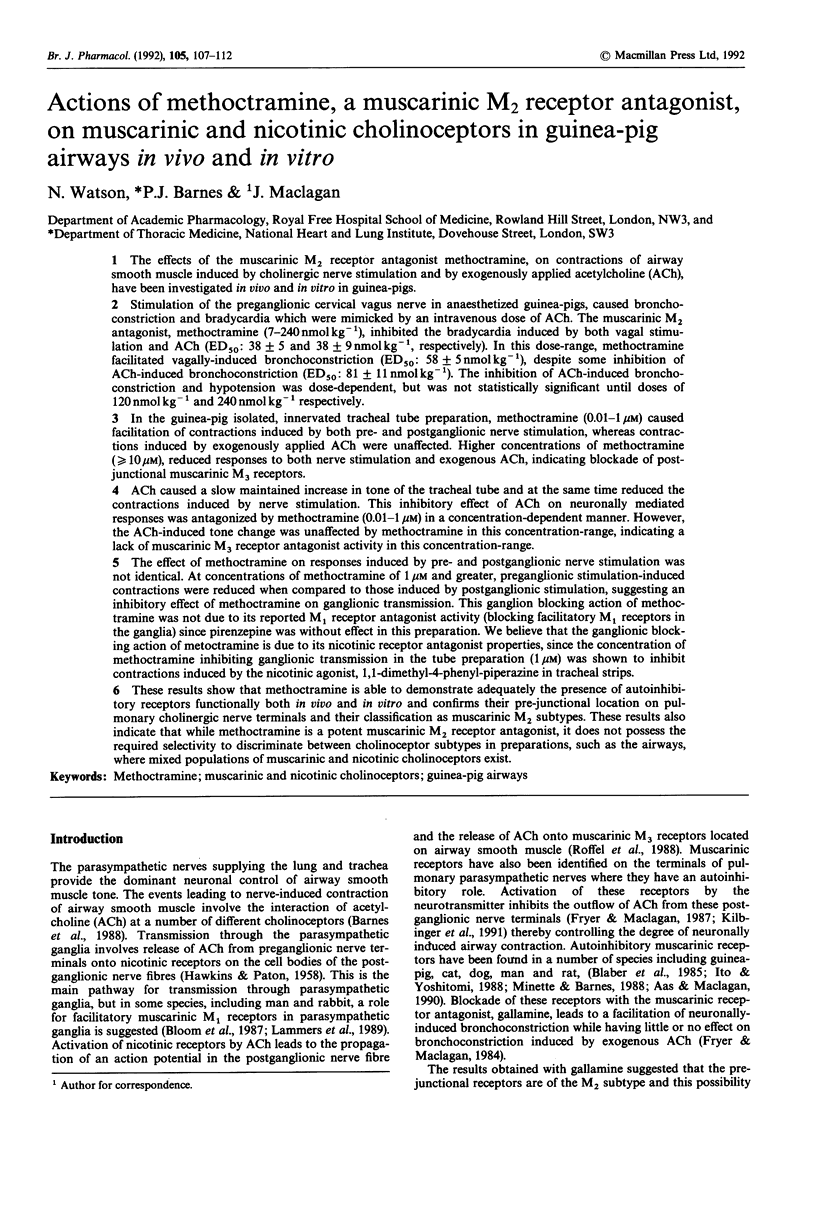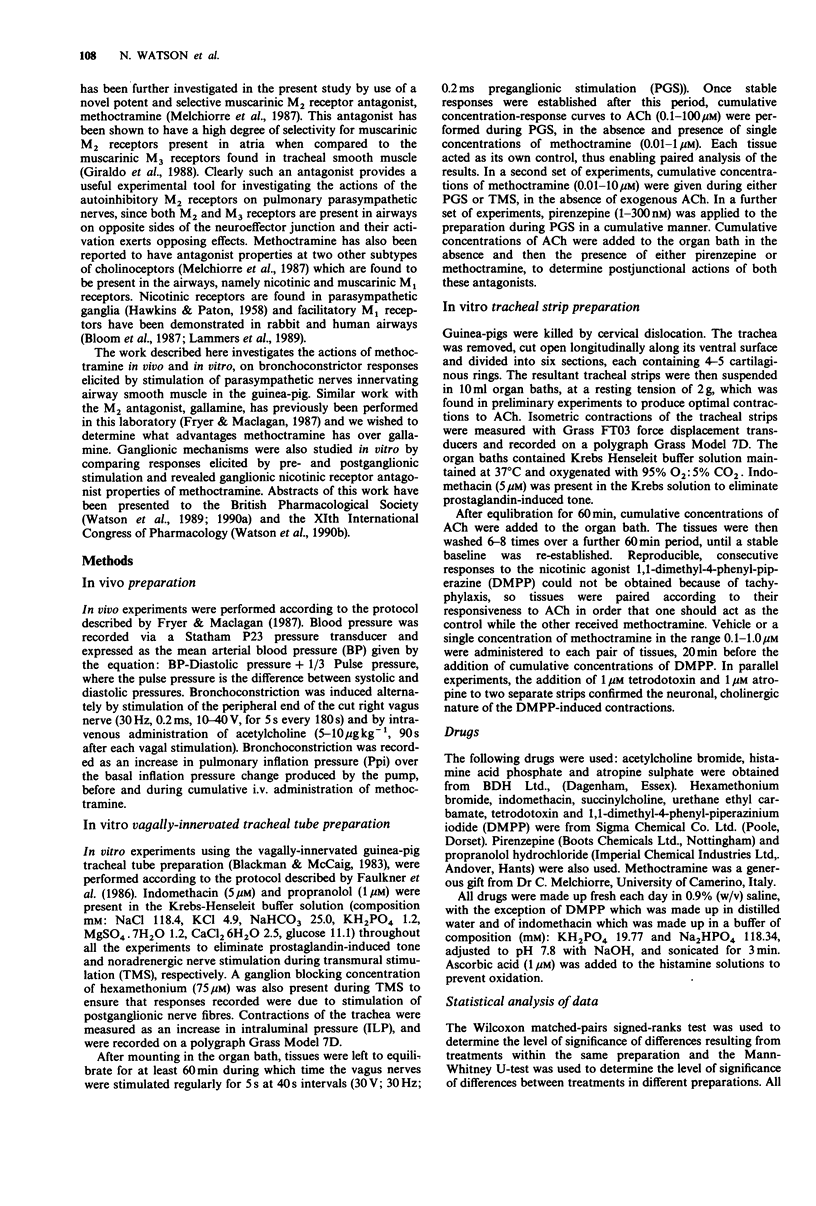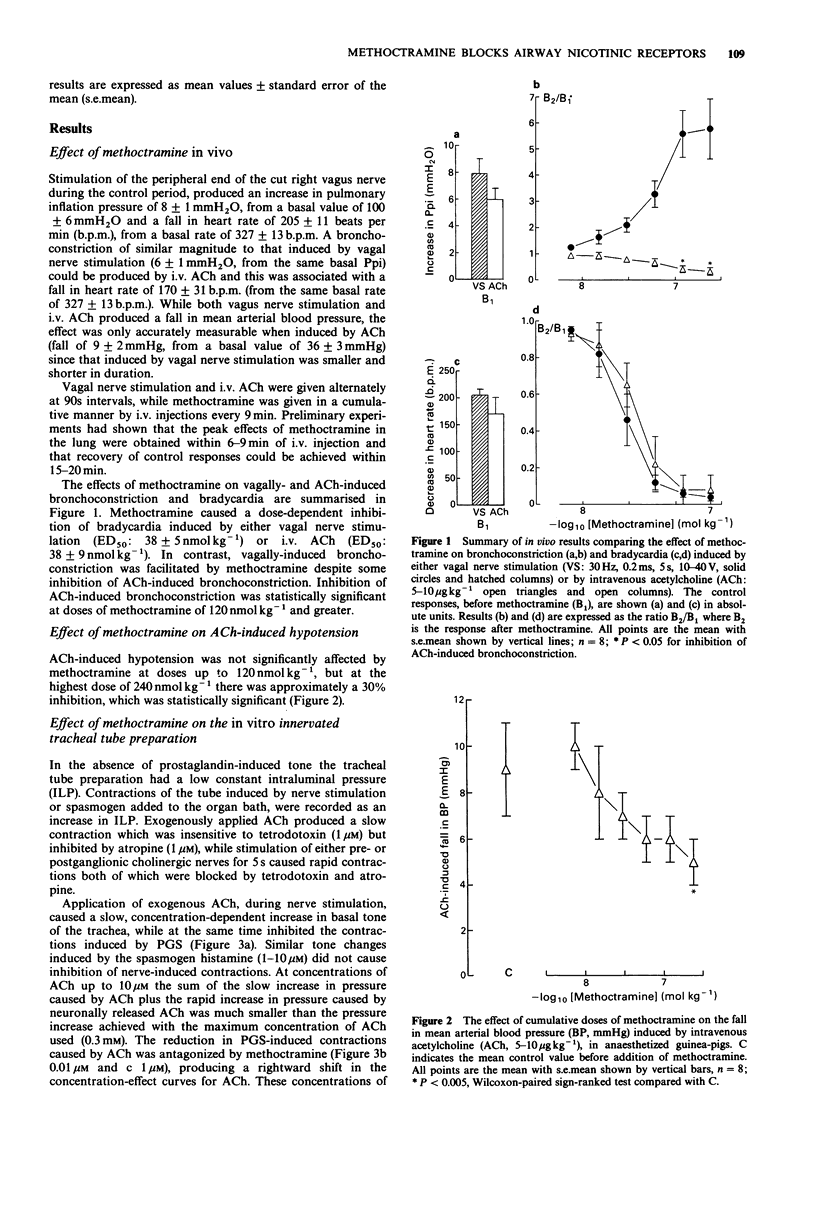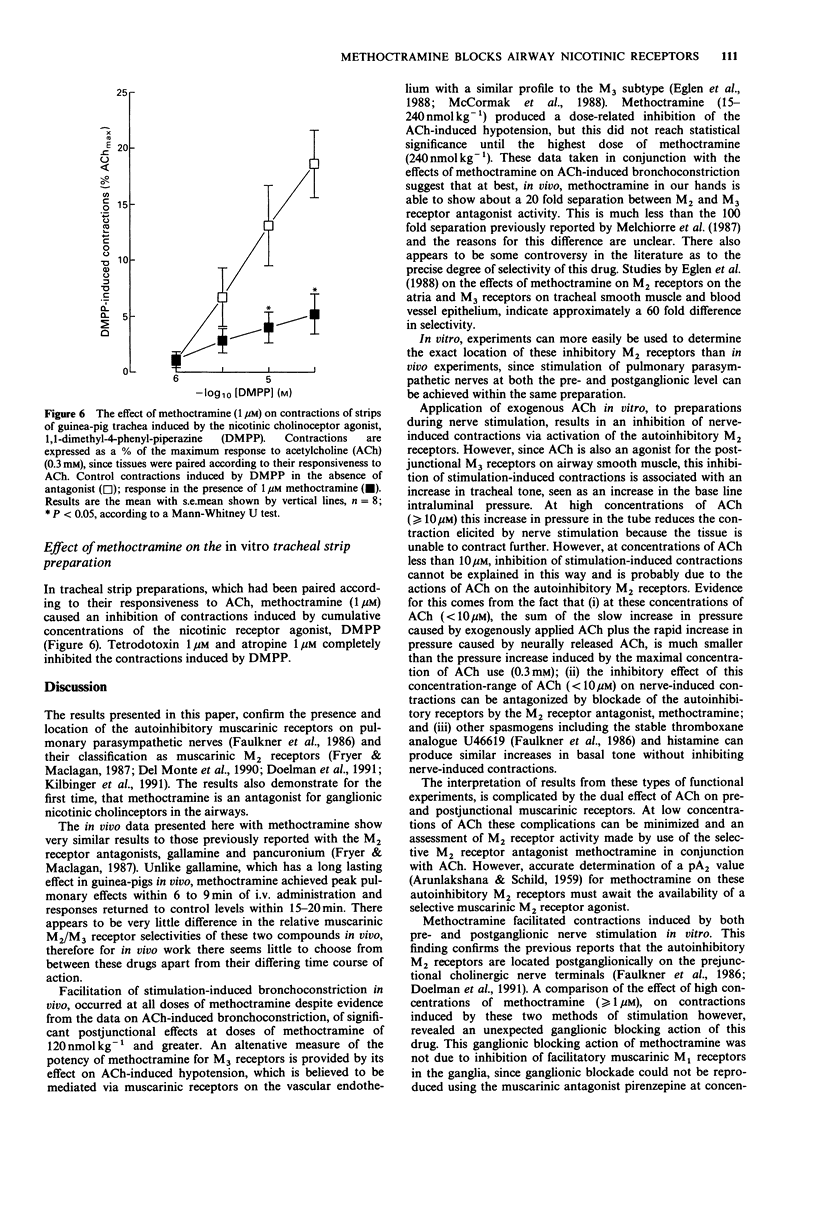Abstract
1. The effects of the muscarinic M2 receptor antagonist methoctramine, on contractions of airway smooth muscle induced by cholinergic nerve stimulation and by exogenously applied acetylcholine (ACh), have been investigated in vivo and in vitro in guinea-pigs. 2. Stimulation of the preganglionic cervical vagus nerve in anaesthetized guinea-pigs, caused bronchoconstriction and bradycardia which were mimicked by an intravenous dose of ACh. The muscarinic M2 antagonist, methoctramine (7-240 nmol kg-1), inhibited the bradycardia induced by both vagal stimulation and ACh (ED50: 38 +/- 5 and 38 +/- 9 nmol kg-1, respectively). In this dose-range, methoctramine facilitated vagally-induced bronchoconstriction (ED50: 58 +/- 5 nmol kg-1), despite some inhibition of ACh-induced bronchoconstriction (ED50: 81 +/- 11 nmol kg-1). The inhibition of ACh-induced bronchoconstriction and hypotension was dose-dependent, but was not statistically significant until doses of 120 nmol kg-1 and 240 nmol kg-1 respectively. 3. In the guinea-pig isolated, innervated tracheal tube preparation, methoctramine (0.01-1 microM) caused facilitation of contractions induced by both pre- and postganglionic nerve stimulation, whereas contractions induced by exogenously applied ACh were unaffected. Higher concentrations of methoctramine (greater than or equal to 10 microM), reduced responses to both nerve stimulation and exogenous ACh, indicating blockade of post-junctional muscarinic M3 receptors. 4 ACh caused a slow maintained increase in tone of the tracheal tube and at the same time reduced the contractions induced by nerve stimulation. This inhibitory effect of ACh on neuronally mediated responses was antagonized by methoctramine (0.01-1 microM) in a concentration-dependent manner.(ABSTRACT TRUNCATED AT 250 WORDS)
Full text
PDF





Selected References
These references are in PubMed. This may not be the complete list of references from this article.
- ARUNLAKSHANA O., SCHILD H. O. Some quantitative uses of drug antagonists. Br J Pharmacol Chemother. 1959 Mar;14(1):48–58. doi: 10.1111/j.1476-5381.1959.tb00928.x. [DOI] [PMC free article] [PubMed] [Google Scholar]
- Aas P., Maclagan J. Evidence for prejunctional M2 muscarinic receptors in pulmonary cholinergic nerves in the rat. Br J Pharmacol. 1990 Sep;101(1):73–76. doi: 10.1111/j.1476-5381.1990.tb12091.x. [DOI] [PMC free article] [PubMed] [Google Scholar]
- Barnes P. J., Minette P., Maclagan J. Muscarinic receptor subtypes in airways. Trends Pharmacol Sci. 1988 Nov;9(11):412–416. doi: 10.1016/0165-6147(88)90069-7. [DOI] [PubMed] [Google Scholar]
- Blaber L. C., Fryer A. D., Maclagan J. Neuronal muscarinic receptors attenuate vagally-induced contraction of feline bronchial smooth muscle. Br J Pharmacol. 1985 Nov;86(3):723–728. doi: 10.1111/j.1476-5381.1985.tb08951.x. [DOI] [PMC free article] [PubMed] [Google Scholar]
- Blackman J. G., McCaig D. J. Studies on an isolated innervated preparation of guinea-pig trachea. Br J Pharmacol. 1983 Dec;80(4):703–710. doi: 10.1111/j.1476-5381.1983.tb10061.x. [DOI] [PMC free article] [PubMed] [Google Scholar]
- Bloom J. W., Yamamura H. I., Baumgartener C., Halonen M. A muscarinic receptor with high affinity for pirenzepine mediates vagally induced bronchoconstriction. Eur J Pharmacol. 1987 Jan 6;133(1):21–27. doi: 10.1016/0014-2999(87)90201-9. [DOI] [PubMed] [Google Scholar]
- Del Monte M., Omini C., Subissi A. Mechanism of the potentiation of neurally-induced bronchoconstriction by gallamine in the guinea-pig. Br J Pharmacol. 1990 Mar;99(3):582–586. doi: 10.1111/j.1476-5381.1990.tb12972.x. [DOI] [PMC free article] [PubMed] [Google Scholar]
- Doelman C. J., Sprong R. C., Nagtegaal J. E., Rodrigues de Miranda J. F., Bast A. Prejunctional muscarinic receptors on cholinergic nerves in guinea pig airways are of the M2 subtype. Eur J Pharmacol. 1991 Jan 25;193(1):117–119. doi: 10.1016/0014-2999(91)90209-9. [DOI] [PubMed] [Google Scholar]
- Eglen R. M., Montgomery W. W., Dainty I. A., Dubuque L. K., Whiting R. L. The interaction of methoctramine and himbacine at atrial, smooth muscle and endothelial muscarinic receptors in vitro. Br J Pharmacol. 1988 Dec;95(4):1031–1038. doi: 10.1111/j.1476-5381.1988.tb11736.x. [DOI] [PMC free article] [PubMed] [Google Scholar]
- Faulkner D., Fryer A. D., Maclagan J. Postganglionic muscarinic inhibitory receptors in pulmonary parasympathetic nerves in the guinea-pig. Br J Pharmacol. 1986 May;88(1):181–187. doi: 10.1111/j.1476-5381.1986.tb09485.x. [DOI] [PMC free article] [PubMed] [Google Scholar]
- Fryer A. D., Maclagan J. Muscarinic inhibitory receptors in pulmonary parasympathetic nerves in the guinea-pig. Br J Pharmacol. 1984 Dec;83(4):973–978. doi: 10.1111/j.1476-5381.1984.tb16539.x. [DOI] [PMC free article] [PubMed] [Google Scholar]
- Fryer A. D., Maclagan J. Pancuronium and gallamine are antagonists for pre- and post-junctional muscarinic receptors in the guinea-pig lung. Naunyn Schmiedebergs Arch Pharmacol. 1987 Apr;335(4):367–371. doi: 10.1007/BF00165549. [DOI] [PubMed] [Google Scholar]
- Giraldo E., Micheletti R., Montagna E., Giachetti A., Viganò M. A., Ladinsky H., Melchiorre C. Binding and functional characterization of the cardioselective muscarinic antagonist methoctramine. J Pharmacol Exp Ther. 1988 Mar;244(3):1016–1020. [PubMed] [Google Scholar]
- HAWKINS D. F., PATON W. D. Responses of isolated bronchial muscle to ganglionically active drugs. J Physiol. 1958 Dec 4;144(2):193–219. doi: 10.1113/jphysiol.1958.sp006095. [DOI] [PMC free article] [PubMed] [Google Scholar]
- Ito Y., Yoshitomi T. Autoregulation of acetylcholine release from vagus nerve terminals through activation of muscarinic receptors in the dog trachea. Br J Pharmacol. 1988 Mar;93(3):636–646. doi: 10.1111/j.1476-5381.1988.tb10321.x. [DOI] [PMC free article] [PubMed] [Google Scholar]
- Kilbinger H., Schneider R., Siefken H., Wolf D., D'Agostino G. Characterization of prejunctional muscarinic autoreceptors in the guinea-pig trachea. Br J Pharmacol. 1991 Jul;103(3):1757–1763. doi: 10.1111/j.1476-5381.1991.tb09859.x. [DOI] [PMC free article] [PubMed] [Google Scholar]
- Kohlenbach A., Schlicker E. GABAB receptor-mediated inhibition of the neurogenic vasopressor response in the pithed rat. Br J Pharmacol. 1990 Jun;100(2):365–369. doi: 10.1111/j.1476-5381.1990.tb15810.x. [DOI] [PMC free article] [PubMed] [Google Scholar]
- Lammers J. W., Minette P., McCusker M., Barnes P. J. The role of pirenzepine-sensitive (M1) muscarinic receptors in vagally mediated bronchoconstriction in humans. Am Rev Respir Dis. 1989 Feb;139(2):446–449. doi: 10.1164/ajrccm/139.2.446. [DOI] [PubMed] [Google Scholar]
- McCormack D. G., Mak J. C., Minette P., Barnes P. J. Muscarinic receptor subtypes mediating vasodilation in the pulmonary artery. Eur J Pharmacol. 1988 Dec 13;158(3):293–297. doi: 10.1016/0014-2999(88)90083-0. [DOI] [PubMed] [Google Scholar]
- Melchiorre C., Cassinelli A., Quaglia W. Differential blockade of muscarinic receptor subtypes by polymethylene tetraamines. Novel class of selective antagonists of cardiac M-2 muscarinic receptors. J Med Chem. 1987 Jan;30(1):201–204. doi: 10.1021/jm00384a034. [DOI] [PubMed] [Google Scholar]
- Minette P. A., Barnes P. J. Prejunctional inhibitory muscarinic receptors on cholinergic nerves in human and guinea pig airways. J Appl Physiol (1985) 1988 Jun;64(6):2532–2537. doi: 10.1152/jappl.1988.64.6.2532. [DOI] [PubMed] [Google Scholar]
- Roffel A. F., Elzinga C. R., Van Amsterdam R. G., De Zeeuw R. A., Zaagsma J. Muscarinic M2 receptors in bovine tracheal smooth muscle: discrepancies between binding and function. Eur J Pharmacol. 1988 Aug 9;153(1):73–82. doi: 10.1016/0014-2999(88)90589-4. [DOI] [PubMed] [Google Scholar]


